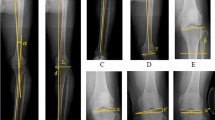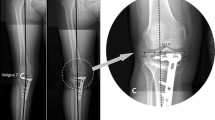Abstract
Purpose
This study aimed to assess the effect of soft tissue correction due to knee joint laxity, which induces alignment error after hybrid closed-wedge high tibial osteotomy (CWHTO). In addition, to verify whether postoperative soft tissue correction can be predicted from preoperative radiographic parameters.
Methods
A retrospective evaluation of data from patients treated by CWHTO in 2016–2019 was performed. Standing full-length anteroposterior radiograph measurement was performed pre- and post-surgery, and short anteroposterior radiographs of the knee under maximal manual varus and valgus stress were taken preoperatively. The weight-bearing line, hip–knee–ankle angle (HKA), medial proximal tibial angle (MPTA), and joint line convergence angle (JLCA) were measured, in addition to JLCA under varus or valgus conditions. Soft tissue correction was defined as ΔHKA minus ΔMPTA. Multiple regression analysis was performed to evaluate preoperative factors that could influence soft tissue correction.
Results
Data from 49 knees were included in the analysis. The mean soft tissue correction was 3.2°, which indicates an over-correction. Multiple regression analysis revealed that JLCA (β = 0.642; p < 0.001) and valgus JLCA (β = − 0.422; p = 0.001) were significantly associated with postoperative soft tissue correction. The final model of the regression formula was described by the following equation: postoperative soft tissue correction = 0.691 × JLCA − 0.411 × valgus JLCA − 0.399.
Conclusion
Preoperative values for JLCA and JLCA under valgus stress are associated with soft tissue correction. Surgeons should, therefore, consider these measurements to achieve postoperative limb alignment.



Similar content being viewed by others
References
Akamatsu Y, Kumagai K, Kobayashi H, Tsuji M, Saito T (2018) Effect of increased coronal inclination of the tibial plateau after opening-wedge high tibial osteotomy. Arthroscopy 34:2158–2169
Akizuki S, Shibakawa A, Takizawa T, Yamazaki I, Horiuchi H (2008) The long-term outcome of high tibial osteotomy: a ten- to 20-year follow-up. J Bone Joint Surg Br 90:592–596
Billings A, Scott DF, Camargo MP, Hofmann AA (2000) High tibial osteotomy with a calibrated osteotomy guide, rigid internal fixation, and early motion. Long-term follow-up. J Bone Joint Surg Am 82:70–79
Bito H, Takeuchi R, Kumagai K, Aratake M, Saito I, Hayashi R et al (2009) A predictive factor for acquiring an ideal lower limb realignment after opening-wedge high tibial osteotomy. Knee Surg Sports Traumatol Arthrosc 17:382–389
Gaasbeek RD, Nicolaas L, Rijnberg WJ, van Loon CJ, van Kampen A (2010) Correction accuracy and collateral laxity in open versus closed wedge high tibial osteotomy. A one-year randomised controlled study. Int Orthop 34:201–207
Goto N, Okazaki K, Akiyama T, Akasaki Y, Mizu-Uchi H, Hamai S et al (2018) Alignment factors affecting the medial meniscus extrusion increases the risk of osteoarthritis development. Knee Surg Sports Traumatol Arthrosc. https://doi.org/10.1007/s00167-018-5286-7
Kannan A, Hawdon G, McMahon SJ (2012) Effect of flexion and rotation on measures of coronal alignment after TKA. J Knee Surg 25:407–410
Kim JH, Kim HJ, Lee DH (2017) Survival of opening versus closing wedge high tibial osteotomy: a meta-analysis. Sci Rep 7:7296
Kim KI, Kim DK, Song SJ, Lee SH, Bae DK (2017) Medial open-wedge high tibial osteotomy may adversely affect the patellofemoral joint. Arthroscopy 33:811–816
Koshino T, Morii T, Wada J, Saito H, Ozawa N, Noyori K (1989) High tibial osteotomy with fixation by a blade plate for medial compartment osteoarthritis of the knee. Orthop Clin North Am 20:227–243
Koshino T, Murase T, Saito T (2003) Medial opening-wedge high tibial osteotomy with use of porous hydroxyapatite to treat medial compartment osteoarthritis of the knee. J Bone Joint Surg Am 85:78–85
Koshino T, Yoshida T, Ara Y, Saito I, Saito T (2004) Fifteen to twenty-eight years' follow-up results of high tibial valgus osteotomy for osteoarthritic knee. Knee 11:439–444
Kubota M, Ohno R, Sato T, Yamaguchi J, Kaneko H, Kaneko K et al (2018) The medial proximal tibial angle accurately corrects the limb alignment in open-wedge high tibial osteotomy. Knee Surg Sports Traumatol Arthrosc 27:2410–2416. https://doi.org/10.1007/s00167-018-5216-8
Kyung BS, Kim JG, Jang KM, Chang M, Moon YW, Ahn JH et al (2013) Are navigation systems accurate enough to predict the correction angle during high tibial osteotomy? Comparison of navigation systems with 3-dimensional computed tomography and standing radiographs. Am J Sports Med 41:2368–2374
Lee DH, Park SC, Park HJ, Han SB (2016) Effect of soft tissue laxity of the knee joint on limb alignment correction in open-wedge high tibial osteotomy. Knee Surg Sports Traumatol Arthrosc 24:3704–3712
Lee DK, Wang JH, Won Y, Min YK, Jaiswal S, Lee BH et al (2019) Preoperative latent medial laxity and correction angle are crucial factors for overcorrection in medial open-wedge high tibial osteotomy. Knee Surg Sports Traumatol Arthrosc. https://doi.org/10.1007/s00167-019-05502-6
Lee OS, Lee SH, Lee YS (2018) Does coronal knee and ankle alignment affect recurrence of the varus deformity after high tibial osteotomy? Knee Surg Relat Res 30:311–318
Ogawa H, Matsumoto K, Ogawa T, Takeuchi K, Akiyama H (2016) Preoperative varus laxity correlates with overcorrection in medial opening wedge high tibial osteotomy. Arch Orthop Trauma Surg 136:1337–1342
Otsuki S, Murakami T, Okamoto Y, Nakagawa K, Okuno N, Wakama H et al (2019) Hybrid high tibial osteotomy is superior to medial opening high tibial osteotomy for the treatment of varus knee with patellofemoral osteoarthritis. Knee Surg Sports Traumatol Arthrosc 27:1332–1338
Ranawat AS, Nwachukwu BU, Pearle AD, Zuiderbaan HA, Weeks KD, Khamaisy S (2016) Comparison of lateral closing-wedge versus medial opening-wedge high tibial osteotomy on knee joint alignment and kinematics in the ACL-deficient knee. Am J Sports Med 44:3103–3110
Saito H, Saito K, Shimada Y, Yamamura T, Yamada S, Sato T et al (2018) Short-term results of hybrid closed-wedge high tibial osteotomy: a case series with a minimum 3-year follow-up. Knee Surg Relat Res 30:293–302
Schroter S, Nakayama H, Yoshiya S, Stockle U, Ateschrang A, Gruhn J (2019) Development of the double level osteotomy in severe varus osteoarthritis showed good outcome by preventing oblique joint line. Arch Orthop Trauma Surg 139:519–527
Takeuchi R, Aratake M, Bito H, Saito I, Kumagai K, Hayashi R et al (2009) Clinical results and radiographical evaluation of opening wedge high tibial osteotomy for spontaneous osteonecrosis of the knee. Knee Surg Sports Traumatol Arthrosc 17:361–368
Takeuchi R, Ishikawa H, Miyasaka Y, Sasaki Y, Kuniya T, Tsukahara S (2014) A novel closed-wedge high tibial osteotomy procedure to treat osteoarthritis of the knee: hybrid technique and rehabilitation measures. Arthrosc Tech 3:e431–437
Thelen P, Delin C, Folinais D, Radier C (2012) Evaluation of a new low-dose biplanar system to assess lower-limb alignment in 3D: a phantom study. Skelet Radiol 41:1287–1293
Acknowledgements
The authors thank Yohei Sasaki for their advice and expert technical assistance with the surgical procedures.
Funding
This study did not receive any funding.
Author information
Authors and Affiliations
Contributions
Designed the study: ST, NK, and YI. Analysed the data: ST and MT. Wrote the manuscript: ST and NK. Supervised the study: YY and TO. All the authors reviewed and approved the final manuscript.
Corresponding author
Ethics declarations
Conflict of interest
The authors declare that they have no conflict of interest.
Ethical approval
All the procedures involving human participants were performed in accordance with the ethical standards of the institutional research committee and with the 1964 Declaration of Helsinki and its later amendments or comparable ethical standards.
Informed consent
For this retrospective study, formal consent was not required.
Additional information
Publisher's Note
Springer Nature remains neutral with regard to jurisdictional claims in published maps and institutional affiliations.
Rights and permissions
About this article
Cite this article
Takagawa, S., Kobayashi, N., Yukizawa, Y. et al. Preoperative soft tissue laxity around knee was associated with less accurate alignment correction after hybrid closed-wedge high tibial osteotomy. Knee Surg Sports Traumatol Arthrosc 28, 3022–3030 (2020). https://doi.org/10.1007/s00167-019-05762-2
Received:
Accepted:
Published:
Issue Date:
DOI: https://doi.org/10.1007/s00167-019-05762-2




